Video Sources 0 Views
- Hot Saturday 1932 Colorized


Synopsis
Table of Contents
ToggleSmall Town Scandal: Hot Saturday (1932) in Stunning Color

Dive into the scandalous world of Hot Saturday, a romantic drama from 1932, now beautifully colorized for a modern viewing experience. Starring Cary Grant in an early role and Nancy Carroll as the object of small-town gossip, this film explores themes of reputation, desire, and social judgment. Perfect for fans of classic cinema and those intrigued by early Hollywood dramas, this HD download offers a glimpse into a bygone era of societal expectations and personal choices.
Hot Saturday Storyline: A Day That Changes Everything
Hot Saturday revolves around Ruth Brock (Nancy Carroll), a level-headed woman working as a secretary in a small town bank. Her life takes an unexpected turn when she accepts a ride home from a wealthy and charismatic newcomer, Romer Sheffield (Cary Grant).Their innocent encounter is misconstrued by the town gossips, leading to scandalous rumors that threaten Ruth’s reputation and her engagement to her fiancé, Bill (Randolph Scott). As the rumors escalate, Ruth must confront the consequences of her actions and decide what truly matters to her. The film explores the themes of social pressure, personal freedom, and the complexities of relationships, set against the backdrop of a close-knit community where everyone knows everyone else’s business. Ultimately, Hot Saturday is a thought-provoking drama about a woman’s struggle to define her own identity in the face of societal expectations.
Movie Cast
The film features a talented cast of actors who bring this dramatic story to life:
- Nancy Carroll as Ruth Brock
- Cary Grant as Romer Sheffield
- Randolph Scott as Bill Frentress
- Lilian Bond as Eva Randolph
- Edward Woods as Conny
Movie Genre
Hot Saturday falls into the genre of romantic drama, exploring themes of love, scandal, and social reputation. Its focus on character development and emotional conflict makes it a captivating and engaging film.
Historical Context: Pre-Code Hollywood
Released in 1932, Hot Saturday is a product of the Pre-Code era of Hollywood, a period characterized by more daring and risque content than what would be allowed after the enforcement of the Motion Picture Production Code in 1934. The film touches on themes of sexuality and social morality that were common in Pre-Code films, offering a glimpse into the cultural attitudes of the time. Hot Saturday reflects the changing landscape of American society during the early 1930s, as traditional values were challenged by new ideas and lifestyles.
Colorization Details
This colorized version of Hot Saturday has been meticulously restored using modern digital techniques, enhancing the visual appeal while preserving the film’s original atmosphere. The colorization process involved carefully analyzing the grayscale tones of the original black and white footage and assigning appropriate colors to each scene. While the specific software used remains proprietary, the techniques employed included advanced algorithms for color palette selection and image enhancement. This painstaking process brings new life to the characters and settings, making the story even more engaging for modern audiences. While some may debate the merits of colorizing classic films, it introduces these films to a broader audience, ensuring their legacy for future generations.
Technical Details
- Director: William A. Seiter
- Screenplay: Josephine Lovett, based on the novel by Harvey Fergusson
- Cinematography: Arthur L. Todd
- Edited by: Harold D. Schuster
- Production Company: Paramount Pictures
- Distributed by: Paramount Pictures
- Runtime: 73 minutes
Technical Specifications
- Download Format: MP4
- Resolution: HD (1080p)
- Compatibility: Compatible with most devices, including smartphones, tablets, computers, and smart TVs.
Reviews and Critical Reception
Hot Saturday (1932) is a notable film for its exploration of social themes and its cast, including early performances by Cary Grant and Randolph Scott. While it may not be as widely known as some of their later works, it remains a fascinating example of Pre-Code Hollywood cinema and a valuable piece for classic film enthusiasts.
FAQs
- Q: What is Hot Saturday about?
- A: Hot Saturday is a romantic drama about a woman whose reputation is threatened by a scandalous rumor in a small town.
- Q: Is Hot Saturday (1932) a well-known Cary Grant film?
- A: While not as famous as some of his later roles, Hot Saturday is an early film in Cary Grant’s career and offers a glimpse into his developing talent.
- Q: Is this version of Hot Saturday colorized?
- A: Yes, this version has been professionally colorized to enhance the viewing experience.
- Q: What makes Hot Saturday interesting for classic film fans?
- A: Hot Saturday offers valuable insights into the Pre-Code era of Hollywood, showcasing the social and cultural attitudes of the time.
- Q: What is the download format?
- A: The download format is MP4, which is compatible with most devices.
- Q: What resolution is the download?
- A: The resolution is HD (1080p), providing a high-quality viewing experience.
Download Now in HD!
Watch Hot Saturday Today!











